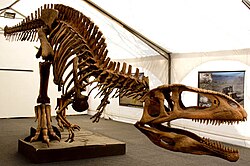Tyrannotitan
|
Tyrannotitan Temporal range: Early Cretaceous, 118 Ma |
|
|---|---|
 |
|
| Mounted skeleton | |
| Scientific classification | |
| Kingdom: | Animalia |
| Phylum: | Chordata |
| Class: | Reptilia |
| Clade: | Dinosauria |
| Order: | Saurischia |
| Suborder: | Theropoda |
| Family: | †Carcharodontosauridae |
| Tribe: | †Giganotosaurini |
| Genus: |
†Tyrannotitan Novas et al., 2005 |
| Species | |
|
|
Tyrannotitan is a genus of huge bipedal carnivorous dinosaur of the carcharodontosaurid family from the Aptian stage of the early Cretaceous period, discovered in Argentina. It is closely related to other giant predators like Carcharodontosaurus and especially Giganotosaurus as well as Mapusaurus. The name means "Tyrant titan".
Tyrannotitan is the geologically oldest known giant carcharodontosaurid along with the more basal Acrocanthosaurus from North America (both found in Aptian-age rocks). Unlike known carcharodontosaurids, this animal lacks pneumaticity extending into the sacral and caudal centra. The scapulocoracoid is fused, and much better developed than that of Giganotosaurus carolinii, yet the arm is very small. Most of the shaft of the scapula is missing.
The acromion curves about 90 degrees from the shaft axis, making it look vaguely tyrannosaurid-like. Whether the sharp difference between taxa is due to evolution or sexual dimorphism in poorly sampled populations of both species, has not been determined (the latter seems unlikely). A proximal caudal has a very tall neural spine (about twice the height of its centrum, judging by the figure). The base of the orbital fenestra is a notch of nearly 90 degrees into the body of the jugal, which contrasts with the rounded base restored for Giganotosaurus and agrees with Carcharodontosaurus favorably. The denticles on its teeth are "chisel-like", and are virtually identical to those of other carcharodontosaurids in having a wrinkled enamel surface, heavily serrated mesial and distal carinae, and labiolingually compressed (laterally flattened) crowns. The femur of the paratype specimen is 1.40 meters long according to Novas et al. Canale et al. recover Tyrannotitan as deeply nested within the tribe Giganotosaurini as its most basal member. Characters that unite the Giganotosaurini include the presence of a postorbital process on the jugal with a wide base, and a derived femur with a weak fourth trochanter and a shallow broad extensor groove at the distal end
...
Wikipedia
